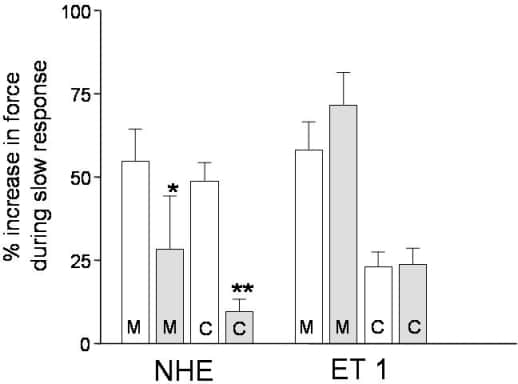Activation of NaH exchange (NHE) has been shown to contribute to the slow inotropic response to stretch in intact cardiac muscle from several species (see Cingolani et al., 2003). We have addressed 2 questions: Is NHE activated by stretch of the single cardiac myocyte? Is NHE activation secondary to endothelin 1 (ET 1) release? Rats were killed humanely. Papillary muscles were stretched from 88 to 98% of the length at which maximum tension is generated, single ventricular myocytes were stretched by around 7% from resting sarcomere length using carbon fibres. The slow response was calculated as the increase in force at 5 min (myocyte) or 10 min (muscle) after stretch as a % of that recorded immediately after stretch. All experiments were performed in the presence of bicarbonate-based physiological solution at room temperature.The NHE inhibitor HOE 642 (5 µM) significantly reduced the magnitude of the slow response to stretch by around 50% in papillary muscle (P<0.05; paired Student’s t-test) and by around 80% in the single myocyte (P<0.01; Figure 1). However, the non-selective ET 1 receptor antagonist PD145065 (1 µM) had no effect on the magnitude of the slow response in either preparation (Figure 1).
It has been proposed by several groups that the slow response seen at the level of the myocyte is Na+-independent. The present data suggests that this is not the case. NHE activation (which will increase intracellular Na+ which consequently exchanges for Ca2+ on the NaCa exchanger) contributes to the slow response in the stretched single myocyte as well as in intact cardiac muscle. Furthermore, we have shown for the first time that NHE activation is not dependent on ET 1 release in either myocytes or muscle from the rat heart. Indeed the lack of effect of PD145065 on the slow response in myocytes or muscle argues against an autocrine or paracrine role for ET 1 in this species.

